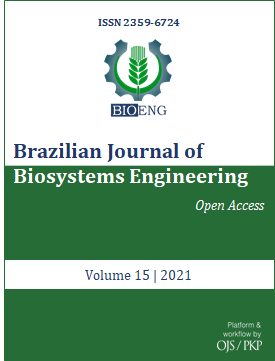PROPOSAL OF A SOLUTION FOR WATER DESALINIZATION USING SOLAR ENERGY
DOI:
https://doi.org/10.18011/bioeng2021v15n2p342-350Keywords:
Solar collector, Potable water, Brackish waterAbstract
Water is abundant on Earth, only about 2.5% is freshwater, and because most of that water is stored as glaciers or deep groundwater, only a small amount of water is easily accessible to humans and animals. This study's motivation is to find a solution for lacking freshwater, converting brackish and seawater to potable water. The main goal was to produce potable water with high-efficiency production using solar energy. The system's main components were the absorber plate painted black, glass cover, insulation, and vessels to collect fresh water. The absorber plate is painted black to absorb solar radiation, preventing its reflection. The plate delivers higher temperatures for saline water to be evaporated and condensed afterward. The basin liner was made of an iron sheet, and the cover is made of ordinary glass, while the basin was covered with glass using silicon rubber. We used 30-degree single slope solar to identify the efficiency of using black stone without using black stone (control). The results showed that the maximum output with black stone and without it was respectively 750 ml and 600 ml; therefore, the use of black stone can increase the productivity for the single slope solar still.
Keywords: Solar collector; Potable water; Brackish water.
Downloads
References
ALTARAWNEHA, I.; RAWADIEH, S.; BATIHA, M.; MKHADMEH, L.; ALROWWAD, S.; TARAWNEH, M. Experimental and numerical performance analysis and optimization of single slope, double slope and pyramidal shaped solar stills. Desalination, v. 423:124-134, 2017. https://doi.org/10.1016/J.DESAL.2017.09.023
BASSAM, A.K.; ABU-HIJLEH, M.; ABU-QUDIAS, S.; AL-KHATEEB, S. Experimental study of a solar still with screens in basin. International Journal of Solar Energy, v. 21(4): 257-266, 2001. https://doi.org/10.1080/01425910108914374
MANCHANDA, H.; KUMAR, M. Study of water desalination techniques and a review on active solar distillation methods. Sustainability, v. 37: 444–464, 2018. https://doi.org/10.1002/ep.12657
HASSAN, H.; ABO-ELFAD, S. Investigation experimentally the impact of condensation rate on solar still performance at different thermal energy storages. Journal of Energy Storage, v. 34: e102014. 2021. https://doi.org/10.1016/j.est.2020.102014.
KANNAN, N.; VAKEESAN, D. Solar energy for future world: A review. Renewable & Sustainable Energy Reviews, v. 62: 1092–1105, 2016. https://doi.org/10.1016/j.rser.2016.05.022
KARAGIANNIS, I.C.; SOLDATOS, P.G. Water desalination cost literature: Review and assessment. Desalination, v. 223 (1–3): 448-456, 2008. https://doi.org/10.1016/j.desal.2007.02.071
KELLY, N. A.; GIBSON, T. L. Improved photovoltaic energy output for cloudy conditions with a solar tracking system. Solar Energy, v. 83: 2092-2102, 2009. https://doi.org/10.1016/j.solener.2009.08.009.
LINS, F. DE S.; SILVA, V. A. DA; NÄÄS, I. A.; LIMA, N. D. DA S.; SILVA, M. C. DA. The efficacy of a dual-axis solar tracking device in tropical climate. Research, Society and Development, v. 9 (11): e1029119637, 2020. https://doi.org/10.33448/rsd-v9i11.9637
MANOKAR, A.M.; VIMALA, V.; PRINCE WINSTON, D.; RAMESH, R.; SATHYAMURTHY R.; NAGARAJAN P. K.; BHARATHWAAJ R. Different parameters affecting the condensation rate on an active solar still—A review. Sustainable Energy, v. 38: 286-296, 2018. https://doi.org/10.1002/ep.12923
MILLER, S.; SHEMER, H.; SEMIAT R. Energy and environmental issues in desalination. Desalination, v. 366, 2-8: 2015. https://doi.org/10.1016/j.desal.2014.11.034
MURUGAVEL, K.K.; SIVAKUMAR, S.; AHAMED, J.R.; CHOCKALINGAM, K.K.S.K.; SRITHAR, K. Single basin double slope solar still with minimum basin depth and energy storing materials. Applied Energy, 87, 514-523, 2010. https://doi.org/10.1016/j.apenergy.2009.07.023
PANCHAL, H.N.; SHAH, P.K. Performance improvement of solar stills via experimental investigation. International Journal of Advanced Design and Manufacturing Technology, v. 5(5): 19-23, 2012. https://www.sid.ir/en/Journal/ViewPaper.aspx?ID=365337
SIVAKUMAR, V.; SUNDARAM, E.G. Improvement techniques of solar still efficiency: A review. Renewable Sustainable Energy Review, v. 28: 246–264, 2013.
WI-Worldwatch Institute. (2017). State of the World 2017. Earth ED: Rethinking Education on a Changing Planet. ISBN 9781610918428
Downloads
Published
How to Cite
Issue
Section
License
Copyright (c) 2021 Revista Brasileira de Engenharia de Biossistemas

This work is licensed under a Creative Commons Attribution 4.0 International License.
Authors who publish in this journal agree to the following terms:
a) Authors retain the copyright and grant the journal the right of first publication, with the work simultaneously licensed under the Creative Commons Attribution License that allows the sharing of the work with recognition of authorship and initial publication in this journal.
b) Authors are authorized to assume additional contracts separately, for non-exclusive distribution of the version of the work published in this journal (eg, publish in an institutional repository or as a book chapter), with recognition of authorship and initial publication in this journal.








